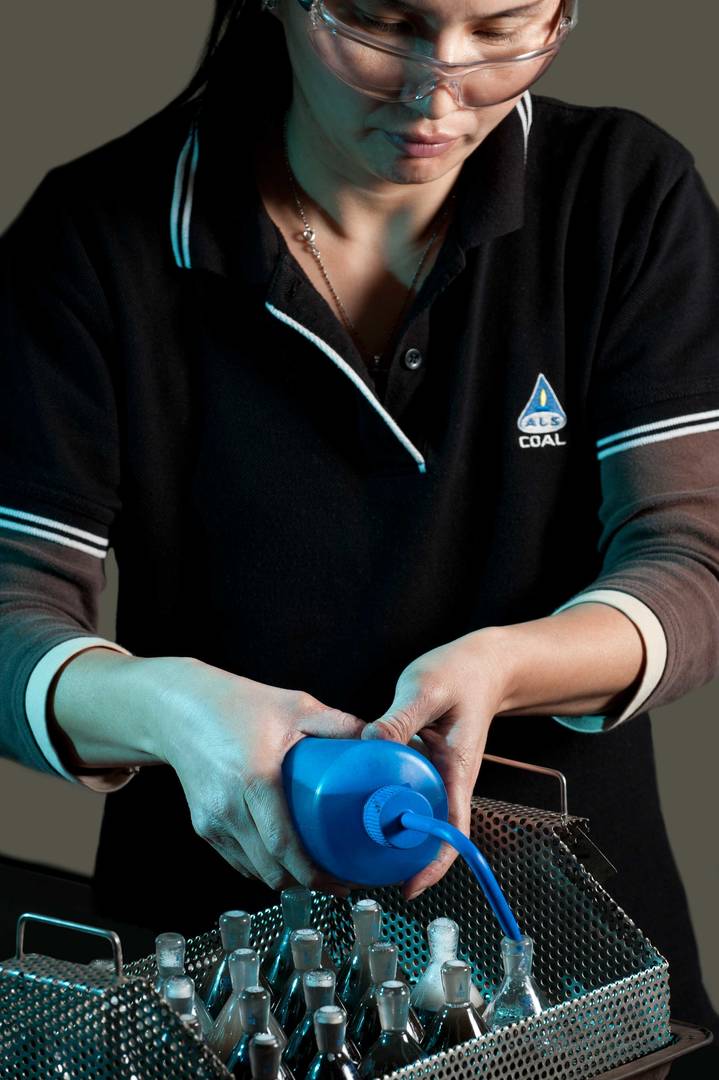Coal density
The density of coal is related to the amount and type of mineral impurities in the coal. The organic components of a coal are less dense than the inorganic components.
Measuring coal density
There are three common ways to measure coal density:
Apparent Relative Density (ARD): This analysis is performed by measuring the mass of coal in air and in water. In this analysis, +2.0 mm coal is examined. Coal that is not pulverized contains blind void spaces within the sample mass and therefore the results produced from an ARD test will produce a lower density compared to a relative density analysis (below). The density of the coal is presented as a ratio of the density of water via the equation below.
Equation: ARD = Ma / ( Ma – Mw)
Where:
- Ma = coal mass in air (g)
- Mw = coal mass water (g)
Application of Apparent Relative Density
- Apparent Relative Density can be used to differentiate between dull coal and carbonaceous mudstone.
- Apparent Relative Density can also be used to determine core recovery. Knowing the length of the core and the Apparent Relative Density of the core, a simple equation allows calculation of the theoretical mass of the core. This can be compared to the weighted mass of the core to determine the percent recovery.
Equation: Recovery (%) = 100 x M / Mt
Where:
- M = actual mass of coal /li>
- Mt = theoretical mass of coal
Relative Density (RD): This analysis is performed by transferring a known mass of milled coal (-212 µm) into a calibrated, stoppered density bottle (density pycnometer). Distilled water and a wetting agent are added and the bottle is treated to thoroughly wet the coal sample and remove trapped air. The relative density is calculated from the displacement of the wetting agent by the coal sample using the equation below.
Equation: RD = Ma / (Ma + Mw – Mt)
Where:
- Ma = mass of coal in air
- Mw = mass of stoppered density bottle filled with water and wetting agent
- Mt = mass of coal, stopped density bottle filled with water and wetting agent
Application of Apparent Relative Density
- When preparing composites of several core samples, for instance when making up a potential working section, to achieve the correct proportions of each component the samples need to be composited using the relative density of each section and the length of each section using the equations below.
Equation:
- Compositing RD = Σ (RD . L) / Σ L
- Compositing Ash = Σ (RD . L . Ash) / Σ (Rd . L)
- Compositing Float/Sink Yield = Σ (RD . L . Yield) / Σ (Rd . L)
- Compositing Float/sink Ash = Σ (RD . L . Yield . F/S Ash) / Σ (Rd . L. Yield)
Where:
- RD = relative density
- L = core length (mm)
- Ash = coal ash (%)
- Yield = float/sink yield (%)
- F/S Ash = float sink ash (%)
- Using Relative Density, In-situ Moisture and Moisture (air-dried basis) the in-situ density of a deposit can be calculated (see Preston and Saunders (1993) “Estimating the in-situ relative density of coal” in: Australian Geology, Vol 9, Journal of the coal Geology Group of the Geological Society of Australia Inc.) using the following equation.
Equation: RDis = RD(ad) x (100 - M(ad) / (100+Rd (ad) . (Mis – M(ad) - Mis)
Where:
- RD = Relative Density of coal
- M = Moisture of coal (air-dried basis)
- Mis = in-situ moisture (see “Moisture in Coal”)
Knowing the Relative Density of the coal in the deposit, it is possible to calculate the mass (tonnes0 of coal in the deposit (see (2014), “Australian guidelines for the estimation and classification of coal resources – 2014 edition, The Coalfields Geology Council of New South Wales and the Queensland Resources Council).
Equation: Mass of deposit = seam area (m2) . seam thickness (m) . RDis
Bulk Density (BD): The bulk density is determined by placing a sample comprising broken coal into a container of known volume and measuring the mass required to fill this container. In any bulk density measurement, the test conditions should simulate or represent, as closely as possible, the actual conditions under which the bulk density needs to be known as the method used will influence the result.
Application of Apparent Relative Density
- Bulk density of coal is a variable applied to various aspects of coal resource evaluation, such as compositing ply analyses of coal attributes that are expressed on a weight percent basis and determining tonnes from volume estimates. In superintending coal shipments a “stowage factor’ may be required. This is the inverse of bulk density i.e. volume / mass.
 Buscar
Buscar
 español
español
 Iniciar sesión
Iniciar sesión






















































